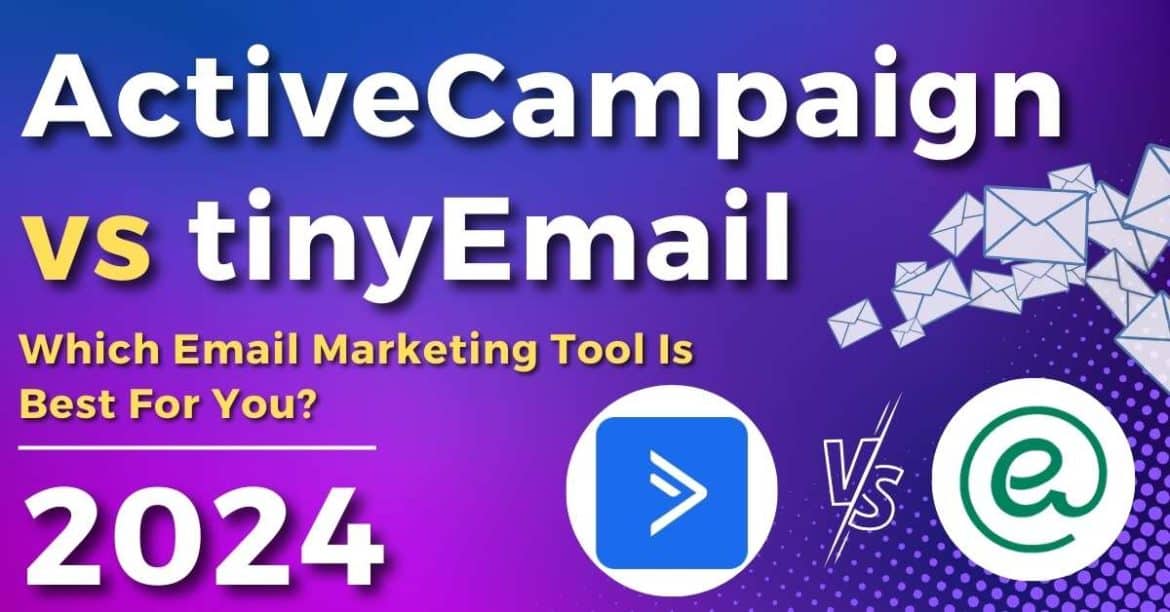ActiveCampaign vs tinyEmail – which is the best email marketing choice to take your business to the next level?
Email marketing is one of the most valuable digital marketing strategies you can engage in to promote your brand and build and nurture your audience.
And trust me, I know all too well just how daunting selecting the perfect email marketing software is for small or micro-business owners.
But I’m guessing you know that! Which is why you’re here.
If you’re tossing up between ActiveCampaign vs tinyEmail, you’re on the right track!
Read more: Top 5 Best FREE Email Marketing Software For Small Business.
ActiveCampaign vs tinyEmail 2024
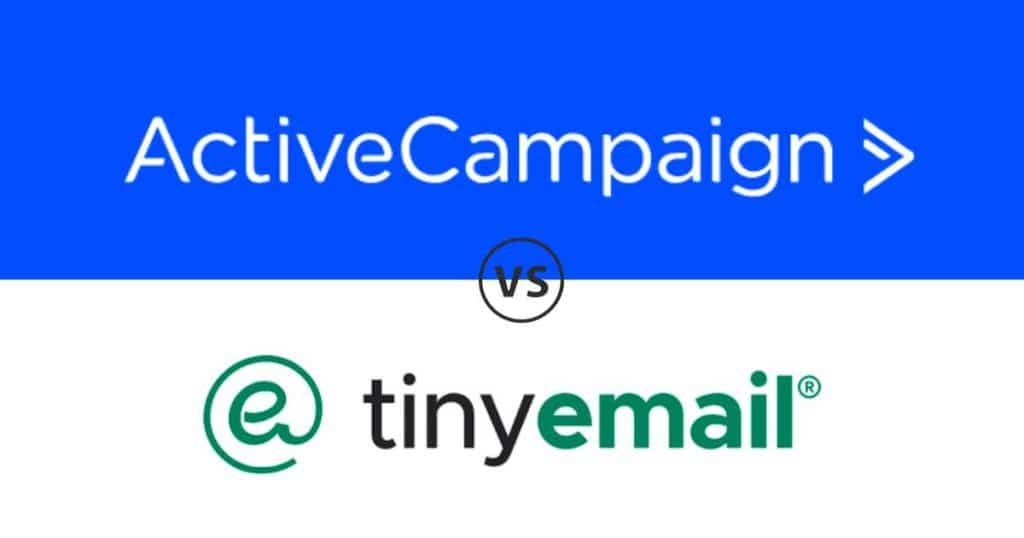
ActiveCampaign and tinyEmail are two impressive email marketing platforms.
But the question remains… is there one that stands out? And which is the best choice for your business?
In this article, that’s exactly what I will find out!
I’ll be comparing their similarities, differences, ease of use, features, pricing, and more.
So, with that said, let’s find the perfect email marketing solution for your business!
What Are They? ActiveCampaign vs tinyEmail
ActiveCampaign and tinyEmail are comprehensive email marketing tools that can help you effectively manage your email list and campaigns.
But what are they, exactly?
ActiveCampaign is a force to be reckoned with regarding email marketing solutions.
Known for its robust features, CRM functionality, customizable options, and advanced automation capabilities, it goes beyond traditional email marketing strategies.
On the other hand, the secret to tinyEmails success lies in its simplicity.
This user-friendly platform offers a refreshingly simple approach that allows anyone to create visually stunning emails.
With tinyEmail’s streamlined features, you can send emails, manage contacts, and track the performance of campaigns with ease – all without sacrificing effectiveness!
Read more about ActiveCampaign in my comprehensive ActiveCampaign review here
What Are The Differences Between ActiveCampaign vs tinyEmail?
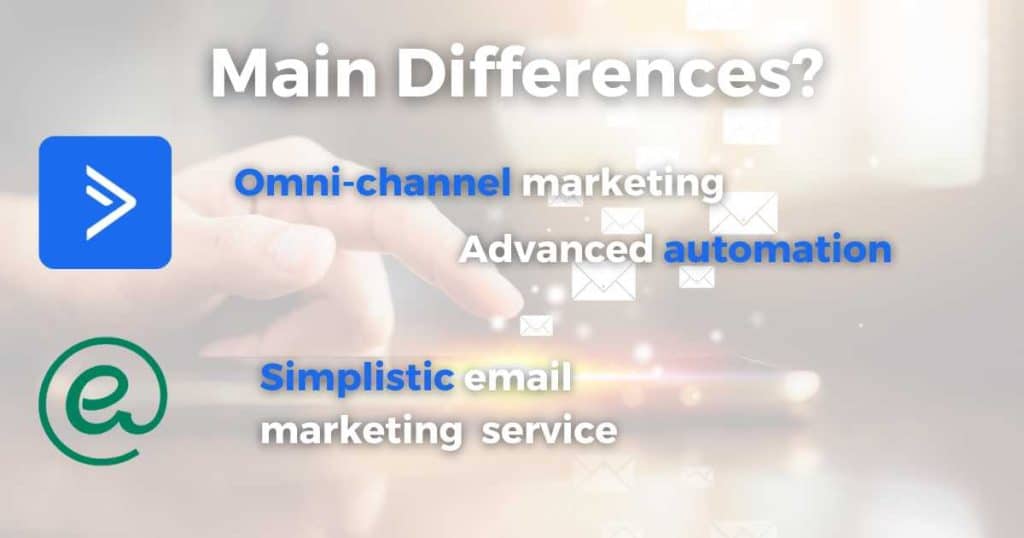
The main difference between both platforms lies in their functionality and features.
With ActiveCampaign’s ability to send personalized emails based on user behavior, you can precisely target your audience.
But for those who are just starting in the world of email marketing, tinyEmail offers everything you need to send campaigns quickly and easily.
ActiveCampagn dominates in terms of omnichannel marketing. In addition to email marketing and automation, you’ll also get:
- SMS marketing.
- A landing pagebuilder
- Facebook Ads capabilities.
tinyEmail is purely for email marketing. And although you can automate and segment with the platform, it’s nowhere near as advanced as ActiveCampaign.
Another main difference is their integration capabilities. ActiveCampaign allows you to connect with over 900 apps.
tinyEmail falls short in this department, with just 300 direct integrations.
Okay, now that you’re up to speed with the main differences between the two – let’s jump into a feature-by-feature comparison!
Read more: ClickFunnels vs ActiveCampaign.
Ease Of Use
tinyEmail is known for its simplicity. And its simplified campaign setup certainly doesn’t disappoint!
From the get-go, simply add your brand logo, colors, social media links, and website to your account. tinyEmail then uses that information to generate email templates that represent your brand.
And when setting up, tinyEmail helps migrate your website, online store, or existing email marketing service into the platform.
I was impressed with their user-friendly dashboard and functional drag-and-drop email editor, where you can easily customize and add your content, images, buttons, blog summaries, and product cards.
Additionally, tinyEmail offers a library of stock images to choose from.
My one criticism would be that it lacks an undo button (which could be helpful for regular email editing).
ActiveCampaign provides a similar drag-and-drop email editor and a more extensive range of campaign types, such as:
- Standard.
- Automated.
- Date-based emails.
- Split-tested.
- Autoresponder.
- RSS.
And although this is useful for experienced marketers, it may be overwhelming for beginners.
Additionally, ActiveCampaign requires upfront contact list uploading, while tinyEmail allows contacts to be uploaded during the email creation process.
ActiveCampaign also lacks a stock image library and native features like AMP blocks and blog summaries, although it does have an undo button.
In my opinion, ActiveCampaign does a pretty good job of keeping things simple, especially considering how much it can do.
However, its extensive feature list can be challenging for some, and because of this, the learning curve is naturally higher than tinyEmails.
Winner = tinyEmail.
Read more: Omnisend vs tinyEmail.
Pricing:
ActiveCampaign:
ActiveCampaign’s pricing structure can be a little confusing – so I’ll break it down for you.
There are 4 plan options (and different plan types within those options).
If you’re needing email and automation marketing, go with the marketing plans:
- Lite: $29 per month.
- Plus: $49 per month.
- Professional: $149 per month.
- Enterprise: Custom price.
And if you want to make use of their incredible built-in CRM services as well as email marketing, check out their awesome Bundle plans.
tinyEmail:
tinyEmail’s pricing plan structure is more straightforward. There are 4 plan tiers, and the price of each differs depending on how many emails you send per month.
For the purpose of this article, the below plan prices are based on teams sending up to 15k emails per month.
- Free: $0 – Includes 500 subscribers.
- Standard: From $15 per month.
- Pro: From $69 per month.
- Custom: Custom pricing.
Winner = tinyEmail
Read more: MailerLite vs ActiveCampaign
ActiveCampaign vs tinyEmail Tools
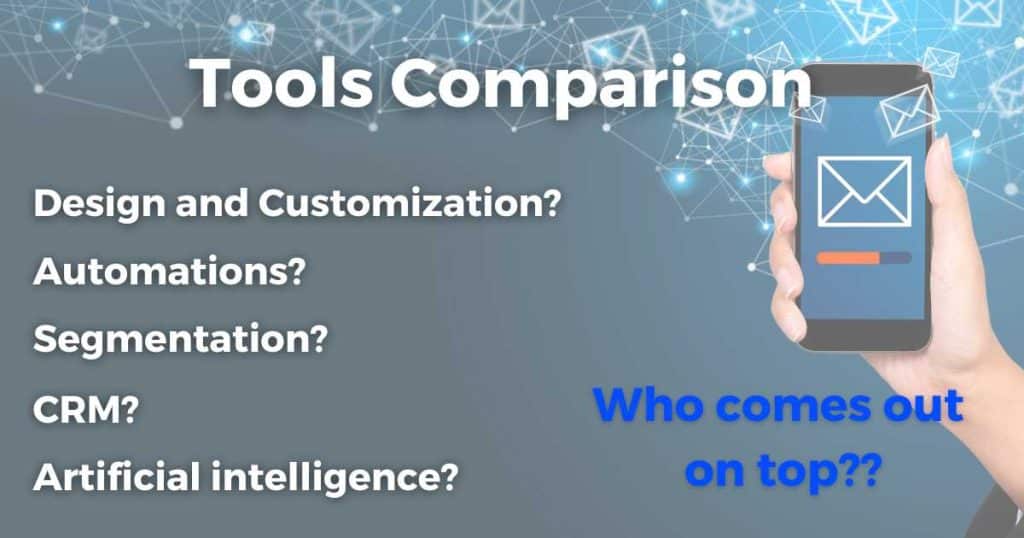
Design and Customization:
First up is design and customization – how well will your designs stand out from the crowd with these two tools?
ActiveCampaign offers a wide range of options for email design. You can start from scratch, use a blank layout, upload your own template, or choose from over 240 pre-designed templates.
The email editor allows complete template customization, including branding, images, and text. And adjusting your colors, font, and spacing is also easy.
One advantage is the ability to customize your fonts and button sizes for mobile viewing directly within the editor (without any coding required)
ActiveCampaign’s template selection is impressive, but it falls short compared to tinyEmail’s extensive library of 600+ templates!
Like ActiveCampaign, tinyEmail allows content and styling adjustments (and some mobile customization options). And if you don’t want to use a template, you can upload your own HTML template.
tinyEmail’s editor and customization options are on par with ActiveCampaign. In fact, I’d go as far as to say that they’re almost a carbon copy of ActiveCampaigns!
Therefore, this one has to go to tinyEmail and its impressive template range!
Winner = tinyEmail.
Read more: ActiveCampaign vs MailChimp.
Automations:
There aren’t many email marketing platforms that stand a chance when it comes to ActiveCampaign’s automated emails.
Their various customizable automated workflows range from basic welcome emails to more complex drip and nurture campaigns.
Their pre-made ‘automation recipes’ (templates) include anything from abandoned carts to post-purchase follow-ups and can be easily changed with your custom content, fields, and tags.
But it doesn’t stop there! You can build your very own automations from scratch and add multiple triggers and split tests to these automations.
You can create triggered campaigns based on specific website page views, dynamic email content, and automated segmentation.
Plus, if you opt for the Sales and Marketing plan bundle plan, you can integrate various channels into your automations, like follow-ups and SMS.
In comparison, tinyEmail’s marketing automation options are limited.
There are only a few basic options like welcome, thank you, and abandoned cart emails. And you can’t build automations from scratch (or customize the existing ones).
The emails are triggered based on predefined actions, and you can’t define specific actions (or edit the content).
Additionally, eCommerce automations are limited to Shopify stores only. Although Shopify is a popular eCommerce platform, it’s a shame tinyEmail doesn’t cater to other platforms.
ActiveCampaign, however, supports integrations with platforms like WooCommerce and BigCommerce.
Winner = ActiveCampaign
Read more: Shopify vs WooCommerce.
Segmentation:
For a fairly basic email marketing tool, tinyEmail actually offers a decent number of segmentation features that you can use to easily send targeted messages!
Segments can be based on various conditions, including email activity and demographic data.
And their AI-powered ‘recommended segments’ are automatically generated based on shared characteristics among subscribers.
For example, you could use AI to send a re-engagement campaign to inactive subscribers or a special voucher to those with upcoming birthdays.
tinyEmail also provides a segment breakdown showing the percentage of subscribers in each segment who have clicked, opened, or unsubscribed from your emails.
Again, ActiveCampaign takes segmentation one step further by offering a wider range of criteria than tinyEmail, including tags, event data (such as website visits), and deal stage.
This could be anything from:
- Geo-location.
- Quiz results.
- Personal interests.
- Past products purchased.
- Customer lifetime value, and much more.
The platform also offers a lead-scoring feature that ranks and prioritizes leads based on various actions and criteria.
And if you opt for one of the higher-paid plans, you’ll get access to the Automations Map feature, which gives you a visual representation of how your automation workflows connect!
While tinyEmail’s prebuilt segments help you get started quickly, ActiveCampaign’s comprehensive segmentation options have the cutting edge!
Winner = ActiveCampaign.
Read more: How to Use Klaviyo Automations.
AI Tools:
Like many online tools, tinyEmail and ActiveCampaign tout their AI capabilities on their websites. But are they actually worth using?
tinyEmail’s AI subject line generator uses its tinyEinstein AI engine to suggest subject lines based on user input. But to be honest, I found that the results were a bit underwhelming and generic.
As I mentioned, their AI-generated prebuilt segments (found within the AI marketing manager) are helpful, but I personally think they could be tailored more specifically to individual subscribers.
tinyEmail does have plans to roll out additional AI features like an email copywriter and automated pre-built sequences, which sounds exciting!
However, ActiveCampaign already boasts an AI email writer that generates descriptions (that you can shorten, lengthen, or modify the tone of).
Plus, they plan to introduce this feature in SMSs, landing pages, and forms!
The predictive content feature automatically personalizes email messages based on past contact engagement, while predictive sending automatically sends messages based on engagement history.
And ActiveCampaign’s AI Automation Builder makes building automation super simple – even for beginners!
Finally, we can’t forget the Win Probability feature, which predicts sales conversions for you based on existing data in your CRM (if you choose to use ActiveCampaign as your CRM of choice).
It’s worth noting that many of ActiveCampaign’s AI features are only available on higher-level subscription plans.
Winner = ActiveCampaign
Read more: 11 Best AI Tools For Small Business.
CRM:
If you’re after a comprehensive email marketing and CRM platform, look no further than ActiveCampaign!
ActiveCampaign’s CRM stands out in its ability to effectively manage deals and opportunities and then integrate those processes with marketing activities. With the CRM, you can:
- Build pipelines.
- Generate deal records.
- Assign deal owners.
- Engage in lead scoring.
- Create one-to-one emails.
- Automate sales communications and processes.
This level of functionality sets ActiveCampaign apart from other email marketing solutions available in the market.
It’s worth mentioning that to access ActiveCampaign’s CRM, you’ll need to subscribe to their Sales Plan or Bundle Plan.
Nevertheless, for teams that don’t want to learn yet another online software, the fact you can merge your CRM and email marketing is truly impressive!
tinyEmail is a standalone email marketing software that currently offers no CRM capabilities.
However, you can integrate your account with popular CRM platforms like HubSpot and Salesforce.
Winner = ActiveCampaign.
Read more: 7 Best CRM Software For Small Business.
ActiveCampaign vs tinyEmail Support:
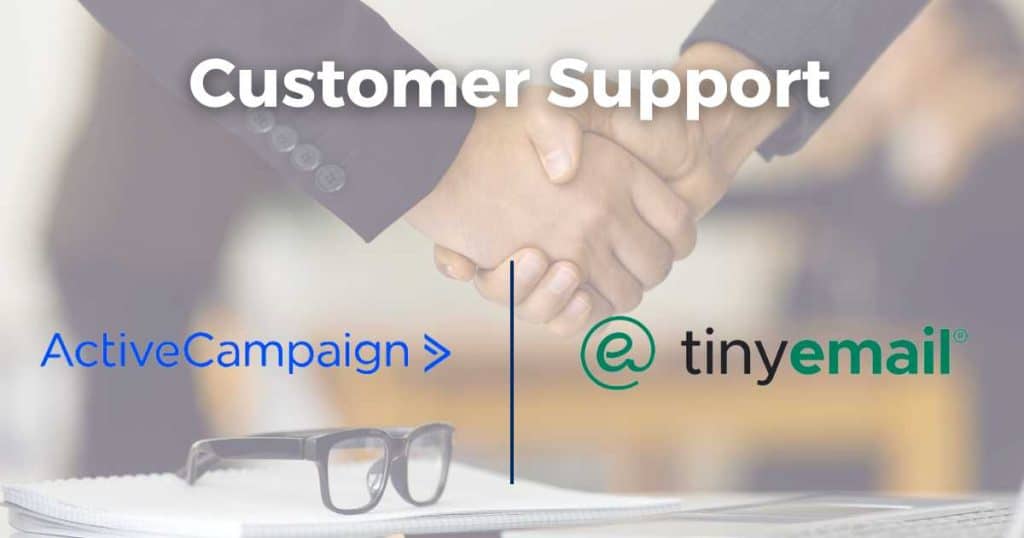
In terms of support, both platforms offer email, live chat, and a range of educational resources.
Even though ActiveCampaign’s learning curve is steeper, the number of lengthy articles, videos, onboarding help, and one-on-one support makes up for it!
And although tinyEmail is fairly easy to set up and use, it also provides a dedicated knowledge base with helpful resources for total newbies.
Plus, Trustpilot reviews often highlight the incredible, prompt, and knowledgeable support provided by tinyEmail!
Winner = Draw
ActiveCampaign vs tinyEmail Who Are They Best For?

The decision between ActiveCampaign and TinyEmail ultimately hinges on your specific business needs and priorities.
If you’re after an advanced automation and email marketing solution with dynamic segmentation and CRM capabilities, there’s no doubt that ActiveCampaign is the one for you.
Its robust features and flexible pricing tiers make it well-suited for businesses of all sizes.
And don’t worry; as you scale and expand your email marketing efforts, ActiveCampaign is with you every step of the way.
In contrast, if simplicity, ease of use, and affordability are your main priorities, or if you’re just getting started with email marketing, tinyEmail is all you need!
tinyEmail is perfect for small eCommerce businesses, bloggers, or freelancers. However, it’s worth noting that TinyEmail may have limitations regarding scalability.
Therefore, I’d only recommend tinyEmail for individuals and small teams!
My Final Thoughts
And you made it! That concludes this ActiveCampaign vs tinyEmail comparison guide.
As you can see, ActiveCampaign won in most categories – and it’s no surprise, really (considering how much they offer!)
But in saying that, it’s not the best choice for everyone. If you don’t need all the bells and whistles, tinyEmail is a pretty good option.
Plus, tinyEmail is a fairly new product, so I suspect we will see some improvements over the coming months/years!
You can try ActiveCampaign for free for 14 days or opt for a 7-day full-featured trial on tinyEmail.
So what will it be? ActiveCampaign vs tinyEmail?
